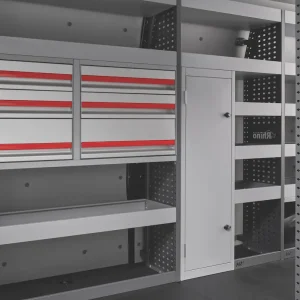Badge engineering is nothing new. The Pininfarina-designed Morris Oxfords and Austin Cambridges of the late ‘50s and ‘60s wore different logos, but were essentially the same car made by the same manufacturer: BMC.
So it is with today’s Citroen Berlingo, Peugeot Partner, and Vauxhall Combo. While they may have different styling quirks, they are all fundamentally the same van, and all produced by the same global automotive giant: Stellantis. In a sign of the times, all three of them are available with electric power trains as well as internal combustion engines.
Thanks to a joint-venture agreement with Stellantis, Toyota markets an identical model as the Proace City, and we have been taking a look at the electric version. The four battery-powered vans shared the What Van? Electric Van of the Year Award for 2022.
Proace City Electric boasts a motor delivering up to 100kW powered by a 50kWh lithium-ion battery that sits under the cargo bed. Range between recharges is up to 168 miles according to the worldwide harmonised light vehicle test procedure (WLTP).
All City Electrics come in icon trim, and customers can opt for either the L1 (2,785mm wheelbase) or the longer L2 (2,975mm wheelbase). The former offers a 3.3m3 cargo area and an 800kg payload capability while the latter offers 3.9m3 and 750kg respectively.
It is worth noting that payload capacities are in line with those delivered by conventionally-powered models in both cases.
More and more electric vans are permitted to tow trailers these days by their manufacturers, and City Electric can haul one grossing at up to 750kg.
We chose the L1; and we were not disappointed by it.

Load bay
Access to the cargo area is through asymmetric twin rear doors capable of being swung through 180° thanks to easy-to-release catches, plus a sliding door on each side of the body; a standard arrangement on all Proace City Electrics.
They all come with a full-height opaque steel bulkhead too.
Six floor-mounted tie-down points are provided and our demonstrator’s cargo bay was partially protected against scrapes and scratches by extra-cost hardboard panels. Wheel boxes can end up getting bashed and battered during loading and unloading but Proace Electric’s are remarkably slim, which makes them less vulnerable to harm.
The floor was covered by a tailored rubber mat.

Interior and equipment
City Electrics are three-seaters and feature something called smart cargo. The outermost passenger seat folds down to make it easier for extra-long pipes, planks and so on to be pushed through a hatch in the bulkhead, and transported without sticking out through the back doors.
Making use of the smart cargo feature extends the length of the 1,817mm load bed by a, potentially very useful, 1,273mm.
Three seats in a cab of this size are of limited value given that an adult occupant of the middle seat has no legroom whatsoever. Shoulder room is at a premium too.
On the positive side, the back of the middle seat can be folded down to create a desk, and you will find a compartment for valuable items – your phone for instance – under the cushion.
Proace City Electric comes with a high level of specification. The roster embraces manual air-conditioning, front and rear parking sensors, a reversing camera, automatic headlights and wipers, cruise control with an adjustable speed limiter, roof rails and front fog lights.
Also installed is a multi-media package with an 8in colour touchscreen plus smartphone integration with Android Auto and Apple CarPlay. Bluetooth and two USB ports are provided too, as is a DAB radio, while a 12v power point is positioned close to the floor.
For your money you also benefit from automatic headlights and wipers, electric windows as well as heated, power-operated and power-folding exterior mirrors.
Remote audio controls are located on the steering wheel. Both the wheel and the driver’s seat are height-adjustable, and the seat boasts lumbar adjustment as well as an armrest.
In-cab storage facilities include a full-width shelf above the windscreen, two bins, one big, one small, in each of the doors, a lidded but not lockable glove-box with a roomy cubby-hole beneath, a lidded compartment above the instrument panel and a shelf behind the upstanding touchscreen. Cup-holders are positioned at each end of the dashboard, and there is a third one for the middle passenger to use on a centre console.
All the usual electronic safety systems are present and correct.
The line-up includes ABS with electronic brakeforce distribution and brake assist, vehicle stability control, hill-start assist control and downhill assist control. A tyre pressure monitoring system is installed, as are driver and front passenger airbags.
Disc brakes – ventilated at the front, solid at the back – are fitted all round, while the steering is rack-and-pinion.
MacPherson strut-type suspension is installed at the front and a torsion beam set-up is deployed at the back. City Electrics sit on 16in steel wheels, shod in our case with 215/65 R16 Michelin Primacy 3 tyres, graced with plastic trims.

Powertrain
City Electric’s 454v permanent magnet synchronous motor delivers up to 260Nm of torque and its transmission functions in the same way that an automatic gearbox does.
Buyers can specify either a 7kW single-phase or a 11kW three-phase OBC (on-board charger)
The former enables you to charge up the battery in 7.1 hours if you plug the van into a wallbox. Our van was equipped with the 11kW OBC, which cuts the charging time to 4.5 hours assuming that you have access to a three-phase supply.
Whichever on-board charger you have, if you connect the van to a public or business 100kW DC fast-charger then the battery will make its way back up to 80% of its capacity in half-an-hour, says Toyota. Plug it into a domestic three-pin socket, however, and it will take a tedious 30.5 hours to get it from 0% to 100%.
With 216 cells organised in 18 modules, the battery uses a glycol water-cooling system.
The charging point is on the nearside of the van’s body close to the rear doors in both cases. Type 2 cables for connection to a domestic power supply or a wallbox are included in the deal.
Driving
Proace Electric is easy to operate. Rather than a gear lever, you are faced with a switch – Toyota calls it an e-toggle – on a console in front of the dashboard that lets you choose reverse, neutral or drive. It could not be simpler, and you can be on your way once you have released the electronic parking brake.
The only other thing to consider is which drive mode you should select.
A button next to the e-toggle gives you the choice of eco, normal or power, with the motor’s power and torque adjusted in each case.
You use eco (60kW/180Nm) if you need to get the maximum mileage out of whatever charge is left in the battery.
Resorting to it means you will have to put up with a marked decline in performance. Acceleration is restricted, and you will find that your ability to keep up with traffic on the dual carriageway is limited.
Go to power (100kW/260Nm) instead, and you will be rewarded by a firm shove between the shoulder blades. It delivers strong acceleration, motorway cruising speeds are easily maintained, and overtaking is a doddle; but your range suffers accordingly.
Normal (80kW/210Nm) represents the happy medium, and is fine if all you are doing is pottering around the suburbs half-laden.
The cab takes a while to warm up no matter which setting you pick; and if you have decided to opt for eco on a winter’s day, then make sure you have got your thermals on.
Displays in the instrument panel tell you how much charge is left in the battery and how many more miles you can travel before you run out.
You can also see if you are recouping energy while driving.
A regeneration function captures energy that would otherwise be lost when, for example, you lift your foot off the accelerator pedal and coast downhill, and pumps it into the battery. Your range is boosted by several miles as a consequence.
To boost regeneration you press a button near the e-toggle.
While Proace Electric’s ride is not so great, especially when you are travelling across uneven road surfaces unladen, there is no denying that it handles well. In-cab noise levels are of course minimal; apart from the slap of the tyres on the highway.

Operating
In a clever bid to distinguish its model from what is on offer from Citroen, Peugeot and Vauxhall, Toyota is marketing City Electric with what it refers to as a Relax Warranty.
It can last for up to 10 years/100,000 miles so long as certain stipulated conditions are met.
The van comes with an initial three-years/60,000-mile guarantee. Owners can extend it by an additional one year/10,000 miles free of charge each time their vehicle has a scheduled service at a Toyota dealership until the Relax ceiling is reached.
The same package is now being offered with all Toyota light commercials.
City Electric’s battery is protected by a separate eight-year/100,000-mile warranty. Service intervals are set at two years/25,000 miles, with an inspection service at one year/12,500 miles for the first year only.
Side rubbing strips help protect the body, and in our case its metallic paint, from minor damage. Good to see a full-size spare wheel.
The van qualifies for the government’s plug-in grant, but bear in mind that those grants have recently been cut.
For large vans (2.5- to 3.5t) they have been slashed from £8,000 to £5,000. Grants for small vans grossing at below 2.5t such as the Toyota have been reduced from £3,000 to £2,500.
The prices quoted in our factfile are the basic prices, excluding VAT and any grants that may be available.
Electric light commercial vehicles are zero-rated so far as vehicle excise duty is concerned.
Toyota Proace City Electric 11kW OBC Icon L1
Price (ex VAT) £28,024
Price range (ex VAT) £27,899–£28,649
Gross payload 800kg
Load length 1,817mm
Load width (min/max) 1,229mm/1,527mm
Load bay height 1,200mm
Load volume 3.3m3
Loading height 548mm
Rear door aperture 1241mm x 1196mm
Side door aperture 675mm x 1072mm
Gross vehicle weight 2,410kg
Braked/unbraked trailer towing weight 750kg
Residual value 29.9%
Cost per mile 38.7p
Engine size/power 100kW (134hp) electric motor
Torque 260Nm
Gearbox 1sp
Range 168 mls (WLTP)
Battery 50kWh
Warranty 3yrs/60,000mls
Service intervals 2yrs/25,000mls
Insurance group TBA
Price as tested £28,851
Options
Metallic paint £454
Load area ply lining £324
Rubber floor mats £49
Rivals
Nissan eNV200
Price (ex VAT) £26,250–£29,750
Load volume 4.2m3
Gross payload 705kg
Electric motor 80kW
Verdict: Even though it is no longer in the first flush of youth, Nissan is continuing to market the eNV200, despite the fact that its diesel stablemate has now departed. With a claimed range of up to 187 miles and a respectably-sized load area, it remains in contention.
Renault Kangoo Van E-Tech
Price (ex VAT) £26,000–£28,100
Load volume 3.0–4.0m3
Gross payload 605–625kg
Electric motor 44kW
Verdict: The data quoted here refers to the current and soon-to-be-superseded Kangoo. Its successor arrives here this summer, and will be worth the wait. Scooping the What Van? Compact Van of the Year Award for 2022, it offers plenty of cargo space, a decent payload and an upgraded interior.
Renault Zoe Van E-Tech
Price (ex VAT) £26,450–£28,575
Load volume 1.0m3
Gross payload 435–457kg
Electric motor 80kW
Verdict: We were hugely impressed by this little load lugger when we road tested it last year. OK, it has not got the biggest cargo area in the world or the most-generous payload capacity, but at up to 245 miles its claimed range is impressive, and it makes for an ideal zero-emission urban runabout.
The Final Verdict
Design 9/10 – A usable mainstream package that could truly signal the age of the electric van
Cabin 7/10 – Equipped to a high standard, but middle seat lacks leg and shoulder room
Ride 6/10 – Struggles a little on uneven highway surfaces when lightly-laden
Refinement 8/10 – Zero squeaking or creaking, and in-cab noise levels are commendably low
Load area 8/10 – Easy to access with features making it simpler to transport over-length items
Handling/performance 8/10 – Both to a high standard, though the eco mode decreases performance
Powertrain 8/10 – Usefully long range and the choice of drive modes is to be welcomed
Standard equipment 9/10 – Plenty of goodies, with even entry-level models fitted with air-conditioning.
Operating costs 9/10 – An enticing warranty package, and per-mile energy cost remains attractive
What Van? subjective rating 8/10 – A practical zero-emission package that should appeal to a wide range of users
Overall Rating = 80/100





